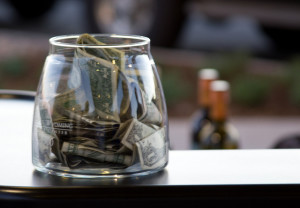 “So, would you like to go on a hot air balloon ride?”, my Turkish tour guide asked. It was going to set me back an extra $200 USD.
“So, would you like to go on a hot air balloon ride?”, my Turkish tour guide asked. It was going to set me back an extra $200 USD.
If I was asked that question 5 years ago, I might have hesitated. I might have started doing comparisons like “$200 USD! That’s like $300 SGD, which is equal to 100 plates of wanton mee, which is how much I spend on food in a month! Is this really worth it?”
But 2 weeks ago, I didn’t hesitate. I smiled, handed over the money, and took that awesome hot air balloon ride.
It’s great to spend money and not feel guilty about it.
No, you don’t have to be an expert at self-delusion. All you need is a systematic way of structuring your finances. Allow me to share it with you today.
The Big Nebulous Mass
 How many spending decisions do we make in a month? Dozens? Hundreds? Thousands?
How many spending decisions do we make in a month? Dozens? Hundreds? Thousands?
How many of us look at the menu in a restaurant and have that familiar mental battle in our heads?
“That appetiser costs $29. Is it really worth it?”
“Of course it’s worth it! You’re SUPER HUNGRY right now and you can use a delicious stuffed mussel in your mouth.”
“Fine, but that means I gotta spend less this week. Maybe I can skip breakfast tomorrow…”
Why do we have these lame mental battles? Because for many of us, we see our money as one big, nebulous mess.
When we check our bank balances, we see just one figure. That one figure represents the combination of our savings, entertainment, parents’ allowance, birthday gifts, etc. Sure, lumping all our money together may help us to feel good when we check our balance, but it comes with some problems.
For example, how do you know when you’re spending too much? When you compare it to a $50,000 bank balance, spending $447 for a pair of jeans may not seem like a big deal, but maybe that money could have been spent on something better.
(I’m not saying that $447 jeans are necessarily bad – but if you’re like me who doesn’t care about clothes, maybe it could have been better spent on say, a staycation).
Or how do you know when you’re spending too little? For example, how do you know whether spending $300 on a hot air balloon is a guilty pleasure, or an indulgence that you rightfully deserve?
What’s This Money Jar Thing?
To get around this problem, there’s a common hack in the personal finance world known as the Money Jar System.
Here’s how it works: Every month you set aside $X every month to different categories. So you might set aside $500 for your future house, $300 for entertainment, $50 for books, etc. When it’s time for you to spend on say, a movie, you dip into your “Entertainment” jar and spend on that movie, guilt-free.
In fact, Li Ka-Shing talked about how you can use the Money Jar System to buy a house and a car in 5 years.
I know what you’re thinking: Oh great, Lionel’s here to lecture me on budgeting again. Can you talk about more important things, like how I can make a gazillion dollars before I’m 45?”
Hold up. This is more than just about putting your money into nice, tidy categories.
The Psychology Behind The Strategy
 Research shows that people suffer from “decision fatigue”, meaning that we tend to make poorer decisions if we’re tired from making other decisions earlier in the day. Think of your decision-making energy as a limited reservoir – the more you use it, the faster it runs out. Would you rather spend it on important decisions like how to tackle that big project, or on trivial ones like what to have for lunch?
Research shows that people suffer from “decision fatigue”, meaning that we tend to make poorer decisions if we’re tired from making other decisions earlier in the day. Think of your decision-making energy as a limited reservoir – the more you use it, the faster it runs out. Would you rather spend it on important decisions like how to tackle that big project, or on trivial ones like what to have for lunch?
That’s why powerhouses like Steve Jobs and Mark Zuckerberg famously wear the same style of clothes every day, so they can save their decision-making energy for more important decisions.
Similarly, all that agonising on whether “is this too expensive” or “do I have enough money” saps your energy. This leaves you less able to make more important decisions that could help you to make a gazillion dollars before your 45th birthday.
That’s where the Money Jar System comes in.
By putting your money into different categories, you know exactly how much you have to spend on a given category at any given time. That way, you never have to second-guess yourself.
Best of all, you’ll never feel guilty about spending on a certain indulgence, because that decision has already been made.
What Are Your Categories?
 So how would you implement this? Well, the first step involves coming up with a few categories you can work with. To give you some ideas, here are some of mine:
So how would you implement this? Well, the first step involves coming up with a few categories you can work with. To give you some ideas, here are some of mine:
Housing renovation costs: Several years ago, I set up a “money jar” for housing and renovation where I deposited some money every month. When it was time for my fiancée and I to choose an Interior Designer, we knew exactly what our budget was, because that was how much I had saved up for.
Wedding: The same goes for weddings. You probably have some idea of when you wanna get married, and a quick Google search will tell you how much your dream wedding will roughly cost. Working backwards, you can save $X every month for it so that you can minimise those future awkward conversations about whether you can afford a floral archway or not.
Travel: Travel is my primary indulgence, so I save a couple of hundred dollars into my Travel Money Jar every month. When it’s time to take my vacation, I withdraw everything from it and spend on experiences like hot air balloon rides and The Wizarding World of Harry Potter, guilt-free.
Networking: I love taking interesting people out to coffee. Not only do I get to learn from their experiences, I find out insider secrets that I would never be able to discover on my own. The cost? A $5 cup of coffee which I budgeted for in my Networking Money Jar. Setting aside just $50 a month is enough for me to arrange several coffee meetings a month.
Awesomeness: I also have an “Awesomeness” Money Jar that I use to spend on anything that helps me grow myself or my business. So things like books, a new suit, an online course to learn SQL, a new Macbook, productivity software, etc. Because I’ve already budgeted for them, I can afford to splurge on these items which may pay off many times over in the future.
Some other Money Jars you can think about: Insurance, car payments, birthday gifts, wedding ang paos, donations, entertainment, clothes, etc
A One-Time Exercise For A Lifetime of Ease
 Does this sound like too much trouble? Are you afraid that you’ll turn it into a hyper-organized nerd who always wears white shirts and arranges all his pens in descending order of height?
Does this sound like too much trouble? Are you afraid that you’ll turn it into a hyper-organized nerd who always wears white shirts and arranges all his pens in descending order of height?
No. What I love about this is that it’s a one-time exercise, in exchange for a lifetime of ease. You set up your system once, and then you’ll never have to worry about whether something is “too expensive” for the rest of your life. How awesome is that?
Also, remember that you don’t have to come up 20 categories for every single expense. Personally, I only track the big ones: things like housing, wedding, travel, insurance etc.
Other smaller expenses like food, grooming, transport, etc get lumped into one big “Miscellaneous” category. You don’t have to worry about budgeting too closely for these, since it’s unlikely that your spending will vary too much in these areas (No one says, “Yeahhhhhh dawg, I’m gonna splurge on transport today and take 7 MRT rides!”).
Today, I want you to do just two things:
- Come up with 4-8 categories which are important to you
- Come up with a budget for each category – e.g. $300 for entertainment, $50 for networking, etc
Once you’re done, share the categories you came up with in the comments below so that we can learn from each other.
Don’t worry about how you’ll implement this in real life. It may sound like it’s a lot of work, but next week, I’ll share with you a simple hack on how you can do all of this automatically, without lifting a finger.
Till next week!
Image credit: Dave Dugdale, aresauburn, leolambertini, NourishingCook,
Hi Lionel,
My Money Jar for each month will roughly be like this:
Retirement Fund-60%
Emergency Fund-30%
Travel/Dining/Utility/Fun Fund/Insurance/Miscellaneous fees-10%
Congrats on your upcoming wedding!
Just wondering if you have managed to enagage the right person to do up your new place?
In your previous blogpost,you mentioned about looking for an ideal interior designer who is able to give his/her 20% effort to achieve 80% result.That was an interesting blog which you have highlighted. I could very much relate to that article.
I have a good recommendation for you if you are still on the hunt.
It’s an established and reputable interior company with 15 years in the industry.
Great workmanship and the 20% factor in that interior designer.
Hope to hear from you soon!
Cool! I’m pretty impressed that you’re allocating 90% of your salary towards retirement and savings, and just 10% to spending! Amazing – maybe you should write a personal finance blog
Yes, definitely interested in the ID as I’m still on the hunt. I’ll email you.
Hey Lionel, awesome article. I use a similar budgeting system and that’s how I indulge, guilt-free. My no. 2 love is travel, after my wife – yeah, of course. Seems like we have some things in common. Writing this right now in a pool-villa in Phuket, haha. YOLO!
JEALOUS
Lol making use of my transport time to pen these categories: travel,investments,wedding,misc, and SPLURGE(can be anything:movies,high end food,luxuries etcetc)
Cheers!
Very nice! Love that SPLURGE is in all caps hahaha
Hi Lionel!
I use the Money Jar system too. I find the OCBC savings goals function really useful for this.
Rachel
Hey Lionel,
That is one feasible system. May I mention one bias though that we should be aware of while living that system for our investments.
Mental Accounting.
We may want to keep the walls between those jars permeable. For example we might have one jar for paying down our mortgage (I am sure that readers of your blog have paid up all their consumer and credit-card debts promptly already). Now in case the interest rates do creep back up to their historic mean, it might be more beneficial to allocate more money to paying down the housing loan than continuing to save money into Fixed Deposit or Savings Account.
We should not pretend to ourselves that some investment money is more important than others: it’s not. And then make sure that when we track our investments we do it for all jars together.
Good point! I find that an annual review of my Money Jars (and how funds should be allocated between them) does the trick for me
I have my own money jar system as well, e.g. for fun (discretionary fund), family (family emergency fund), etc. It helps to start socking money away in separate jars because it doesn’t hurt my monthly budget if I decide to splurge a bit to reward myself using my discretionary fund (that’s accumulated with all the leftover surplus from my monthly budgets) and paying for the cash portion of my mum’s shield plan when she crossed the age band where cash premium is needed.
May i ask if health insurance and endowment plans falls under which category
I normally set up a separate bucket for insurance. I would classify endowment as savings, but it’s up to you